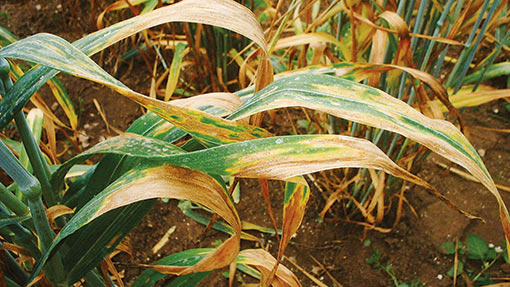Genes hold key to fighting septoria in wheat

Growing wheat with less reliance on azole fungicides will be important to the future viability of the crop, and finding new ways of protecting against Septoria tritici is high on the priority list, says the HGCA.
One way to combat the number one pathogen of wheat became apparent when the LINK project, co-ordinated by James Brown of the John Innes Centre, found combining genes from different wheat varieties could significantly improve septoria resistance in the field.
Research reasons
These two projects (A and B) are contributing to the long-term improvement in the level of resistance to Septoria tritici in wheat varieties while not disadvantaging their yield potential
- Project: A (LINK) – Improved resistance to septoria in superior varieties; B – value of resistance genes in high-yielding wheats
- Timescale: A – October 2004-October 2010; B – October 2011-October 2015
- Researchers: John Innes Centre
- Funders: A – JIC, DEFRA and plant breeders; B – HGCA and JIC doctoral training programme
- Cost: A – HGCA funding of £220,000 in the £1.47m LINK project; B – HGCA funding of £37,500
Key findings
- The LINK project identified genes for robust septoria resistance, some of which may affect grain yield
- Follow-up work is finding other contributory factors to improving the resilience of wheat varieties to septoria
Breeding for resistance to septoria has improved in recent years, so that now only one variety on the HGCA Recommended List has a rating as low as four, and most have a five, classified as moderately good septoria resistance.
Prof Brown is hopeful there will soon be more varieties with ratings of six, seven and above. Currently, there are 10 varieties on the list with a rating of six or above.
The LINK project raised an important question: Are plant breeders able to maintain good septoria resistance when they primarily select varieties for yield and market specifications?
While it’s arguably more difficult to select for septoria resistance coupled with high yield potential, the work concluded that breeders should be able to make progress in producing varieties with both traits.
Newer varieties on the HGCA RL show this is increasingly possible, explains HGCA’s Ellie Marshall. “The current variety Cougar, with a Septoria tritici resistance rating of seven, achieves competitive treated and untreated yields of 103% and 98%, respectively.”
The team at the John Innes Centre mapped the useful genes found within more than 200 current and older wheat varieties, for exploitation by plant breeders in their quest to increase septoria resistance without a yield compromise.
While plant breeders continue trialling new breeding lines with the diverse newly identified and potentially beneficial genes, Prof Brown and PhD student Chris Judge are testing if genes that confer the strongest resistance to septoria inevitably diminish grain yield.
“As the septoria pathogen adapts to fungicides, we will need to select still more resistant wheats. The key is to ask what type of wheat varieties we will need in a decade from now, when fungicide resistance has evolved and EU rules tightened.”
There are many facets to the project. Resistance genes may be just one part of the puzzle, interacting with physiological factors, he explains.
“It’s too early to say what else may be involved in the relationship between septoria resistance and yield. Mr Judge is looking at various features of plant growth and development to evaluate their contribution to controlling the pathogen.
“If the project concludes that some genes have an inextricable link between septoria resistance and yield, breeders will need to use other genes that improve each trait without worsening the other,” says Prof Brown.
HGCA perspective by Ellie Marshall, research and knowledge transfer manager, HGCA
“Septoria tritici is the UK’s most damaging wheat disease and the efficacy of azole fungicides against it continues to decline.
With fewer new actives coming to the market, it seems likely that varietal resistance will take on an even greater role in control. These projects aim to exploit natural resistance to septoria in high-yielding varieties and inform plant breeders of valuable genes to focus on.”

